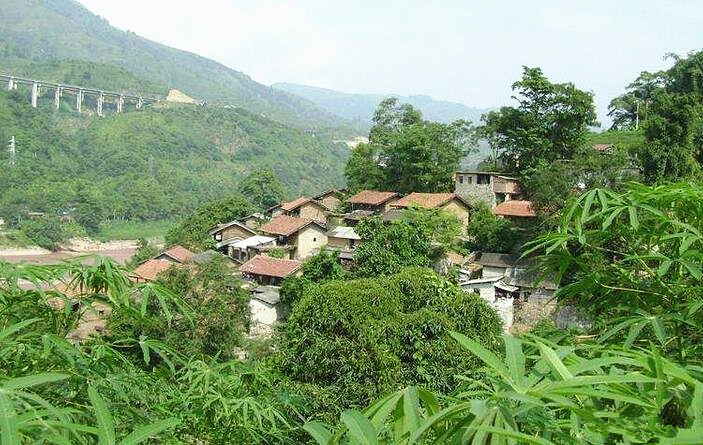
Ten Thousand Mu Banana Forest in Jingping County, Honghe
Overview
The Ten Thousand Mu Banana Forest (金平县勐桥万亩蕉林) in Jingping County (金平县) is located along the road from Manhao (蔓耗) to Mengqiao (勐桥). It is a significant project aimed at developing green industries, adjusting industrial structures, and accelerating poverty alleviation in the region. Local villagers have widely planted high-yield, disease-resistant tissue-cultured banana seedlings, creating a lush, year-round green landscape. The vibrant banana leaves and blossoming buds create a beautiful green tourism route suitable for fruit-picking activities.
Scenic Features
As you cross the Red River (红河) and enter Jingping, you will be greeted by endless rows of banana orchards in the river valley. The dancing green banana leaves sway in the breeze, while Dai (傣族) young women in elaborate floral headdresses, form-fitting white tops, and black skirts weave gracefully through the orchards. This enchanting scene makes one feel as if they have entered a mystical banana forest, where the human figures harmonize beautifully with the banana blossoms. This is the essence of Jingping’s Ten Thousand Mu Banana Forest.
Local Prosperity
The Dai people living in Menglaba (勐拉坝) have prospered by cultivating bananas. The history of banana planting in Jingping is long-standing, benefiting from a “three-dimensional climate” characterized by the phrase “one mountain divides four seasons, ten miles differ in weather.” This unique climate has created 1.4 million mu of land suitable for growing bananas and rubber, mainly in the low-heat river valleys of the Red River and Tengtiao River (藤条江) basins, including Mengla (勐拉), Zhemiz (者米), Jinshuihe (金水河), Mengqiao (勐桥), Dazhai (大寨), Shayi Po (沙依坡), Laojizhai (老集寨), and Laomeng (老勐).
Before 1997, the primary banana variety planted was the local dwarf banana, with some wild bananas and plantains present. In 1970, the total planting area was only 1,047 mu. By 1980, it increased to 7,185 mu, and by 1986, the area expanded to 58,338 mu, marking the first peak period in banana cultivation history in Jingping. Following the introduction of tissue-cultured banana seedlings by Guangzhou Datang Company (广州大唐公司) in 1999, standardized management practices led to significant growth. By the end of 2010, the banana planting area reached 175,000 mu, with an output of 290,000 tons and a value of 435 million yuan. The “Tian Shi” (天时) and “Di Li” (地利) banana brands were established, with the former receiving national “Green Food” A-level certification in 2005. Jingping bananas are now exported to major cities across China and to countries such as Russia, South Korea, and Japan. The “Tian Shi” and “Di Li” bananas can be found in the world-renowned Carrefour supermarkets, establishing Jingping as the “Banana Kingdom” (香蕉王国).
Transition to Modern Farming
The cultivation of bananas in Jingping has transitioned from traditional angled bud seedlings to tissue-cultured planting, moving from hillside cultivation to easier, large-scale farming. This shift has established a more systematic, scientific, and standardized management level for banana farming, quickly making the banana industry a pillar of agriculture in Jingping and a path to wealth for the local population.
Vibrant Economic Activity
Despite being a small border town, Jingping is bustling with life along the roads leading to Mengla, Zhemiz, and from Manhao to Mengqiao and Ma’an Di (马鞍底). The banks of the Red River, Tengtiao River, and Zhemiz River are lined with expansive banana orchards, transforming Menglaba (勐拉坝) and Mengpingba (勐坪坝) into green oases. The grand scale of the banana fields creates the feeling of stepping into a banana forest and the “Banana Kingdom.”
The sight of farmers harvesting bananas, transporting, washing, preserving, and packaging them creates a lively atmosphere. Businessmen from across the country come to buy bananas, resulting in a constant flow of traffic. Visitors to the Ten Thousand Mu Banana Forest can explore the orchards, participate in fruit-picking, and enjoy local Dai cuisine at hidden “farm stays” (农家乐) nestled within the banana groves. Experiencing farm life and reconnecting with nature are highlights of a visit to Jingping.
How to Get There
- From Kunming Changshui International Airport (昆明长水国际机场): Take a taxi or bus to Jingping County, which is approximately 5-6 hours away.
- By Train: Take a train to the nearest station, and then use local transportation to reach Jingping County.
- By Car: Drive along the highways connecting Kunming to Jingping, following the signs to Mengqiao.
Travel Tips
- Best Time to Visit: Late spring and summer are ideal for banana picking and enjoying the lush landscape.
- Local Cuisine: Don’t miss out on trying local Dai dishes, especially those featuring fresh bananas.
- Plan for Outdoor Activities: Wear comfortable clothing and shoes suitable for exploring the orchards.
- Respect Local Culture: Engage with local communities respectfully and enjoy their rich cultural heritage.
- Bring Essentials: Bring sunscreen, a hat, and water, as the sun can be strong in the banana fields.

Location:
















